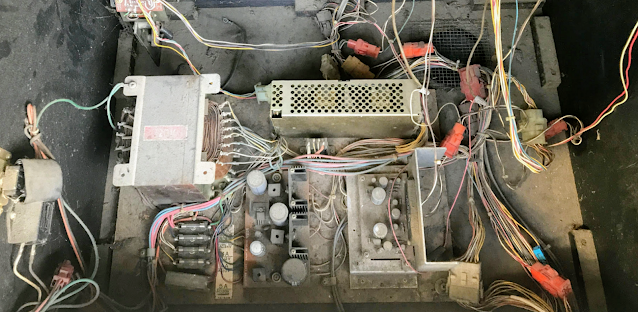More work on Turbo
The engineers at Sega probably knew exactly what they were up against. However, this game, and the layout of components strikes me as laughably convoluted.
They've got this massive transformer putting out numerous voltages. Then a switching power supply which only serves +5V, presumably for the logic board. Next they have a board with three bridge rectifiers, and three 12 volt linear regulators. There are numerous AC voltages going here and there for light bulbs and sensors, and various other accessories. They follow all of that up with a very unique little audio amplifier.
Today, coating all of that, sits 38 years of dust, and who knows what. If this were a fine wine, I would describe it as smelling like 40 year old ashtray, and the garbage below my high school gym bleachers.
Over the years, I've learned to carefully sort through the bits and pieces in the bottom of these cabinets prior to donning a respirator and hitting the whole mess with the shop vac. Often the pieces I find are needed later to repair or reassemble some small component. On some occasions it's been a small spring or clamp that saves the day from total disaster. Below, a pic of the parts pulled from the filthy recesses of this cabinet:
 |
| Notice the two pcb brackets? |
As mentioned in an earlier post, this game wasn't doing the best when it came to sound production. Part of the problem was the 12" woofer. Even after repairing the speaker, there remained an annoying electrical hum, which overpowered the in-game sounds.
In hopes of cleaning up the sound issues, I decided to replace the old capacitors in the linear power assembly board (834-0120), and the stereo amplifier (834-0121).
Some people like to replace every single capacitor they find. Others insist they not be replaced, and that the old capacitors aren't a problem. I tend to get better results when I carefully work through the power supply, replacing whatever I can. So to help put this dilemma to rest (at least in my mind), I purchased a capacitor tester. I chose the Atlas ESR+ by Peak. In truth, I find that more than half of the old capacitors are indeed good. In this case, I replaced all capacitors on the two boards, and only found two were bad. Some had a slightly worse than normal ESR, and others were off when it came to capacitance.
This also gave me the opportunity to clean the gunk away from the boards, as well as the general area around the power supply assembly.
Here is a shot of the bottom of the linear board, which had to be desoldered, then worked on, then re-soldered back in place.
 |
Yes 15 fidgety little wires
|
Here are some before and after shots of the two boards, followed up with a final shot of the power "brick" as it now sits. Still lots more cleaning and tidying to do.
 |
| Yes, still very dirty, but an order of magnitude less dirty. |










No comments:
Post a Comment